RIMMED Baking Sheet Info You Oughta Know
By Alice Osborne
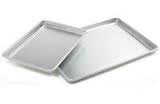 Many times a day, chefs and home cooks might reach for a rimmed baking sheet. They are used for baking cookies, biscuits, scones, and jellyroll cakes, as well as for roasting oven fries and asparagus. With a wire cooling rack set inside, they're good for broiling or roasting meats and in prep work such as holding breaded cutlets before frying. A good rimmed baking sheet isn't just for baking - it's a true kitchen workhorse.
Many times a day, chefs and home cooks might reach for a rimmed baking sheet. They are used for baking cookies, biscuits, scones, and jellyroll cakes, as well as for roasting oven fries and asparagus. With a wire cooling rack set inside, they're good for broiling or roasting meats and in prep work such as holding breaded cutlets before frying. A good rimmed baking sheet isn't just for baking - it's a true kitchen workhorse.
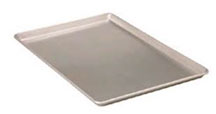 But you'd have a hard time finding these essential pans in most cookware stores. Known as a half-sheet pan in restaurant supply stores, the real thing is made of heavy-gauge metal and measures 18 by 13 inches with a 1-inch rim all around. The closest thing you'll usually find in retail stores is a flimsy, too-small 15 by 10-inch "jellyroll pan." Save your money and hunt for the real deal.
But you'd have a hard time finding these essential pans in most cookware stores. Known as a half-sheet pan in restaurant supply stores, the real thing is made of heavy-gauge metal and measures 18 by 13 inches with a 1-inch rim all around. The closest thing you'll usually find in retail stores is a flimsy, too-small 15 by 10-inch "jellyroll pan." Save your money and hunt for the real deal.
A close look at a variety of rimmed baking sheets tells you that these pans are not identical in materials or construction. Rimmed baking sheets are formed by a machine that presses a flat metal sheet into a predetermined shape, maintaining consistent pressure so the metal will flow in without wrinkling or cracking. They can be made from different alloys and gauges of aluminum, aluminized steel (a thin coat of aluminum over steel), or a tri-ply sandwich of shiny stainless steel with an aluminum core.
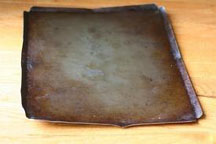 Professional chefs and bakers will all tell you that solid construction is more important than the choice of materials. A too-flimsy pan warps under high heat. I experienced this when the oil pooled at one end of a warping baking sheet as I made fries in a 475 degrees F oven, which resulted in uneven browning of the potatoes. And the thicker the pan, the better. A pan that is too lightweight can transfer heat too intensely, burning batch after batch of cookies. That's when I go "grrrrrr."
Professional chefs and bakers will all tell you that solid construction is more important than the choice of materials. A too-flimsy pan warps under high heat. I experienced this when the oil pooled at one end of a warping baking sheet as I made fries in a 475 degrees F oven, which resulted in uneven browning of the potatoes. And the thicker the pan, the better. A pan that is too lightweight can transfer heat too intensely, burning batch after batch of cookies. That's when I go "grrrrrr."
It's good to understand, though, that warping can happen with any sheet pan, even a heavy-duty one, under certain conditions. Abrupt temperature changes are likely to result in warping, for example, if an empty, cold baking sheet goes into a hot oven. Similarly, having only a few scattered pieces of food on a baking sheet creates different temperature zones on the metal, with some spots where the pan is shielded from heat under the food, and others where it is fully exposed to heat. Different temperature zones contract or expand at different rates as they are heated, which causes warping.
Even though slight warping does not affect the pan's cooking performance, you do want to avoid it. So to help prevent warping your baking sheet, cover the pan's entire surface with food as uniformly as possible, and heat the pan gradually rather than abruptly.
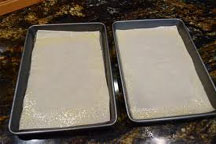 And for super protection to the pan's surface, consider laying parchment paper in it when baking cookies, fries, etc., rather than greasing the pan.
And for super protection to the pan's surface, consider laying parchment paper in it when baking cookies, fries, etc., rather than greasing the pan.
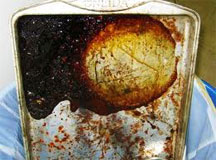 This way the clean-up (if there is any) is easy and you'll never see any burned-on grease build-up, which is such a pain in the neck to clean.
This way the clean-up (if there is any) is easy and you'll never see any burned-on grease build-up, which is such a pain in the neck to clean.
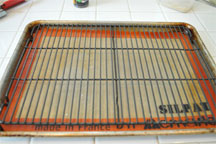 Finally, using a wire grid cooling rack inside the sheet pan can help distribute heat better than cooking meats directly on the pan surface. These extra little steps will keep your pan looking nicer and prolong its life - it's just stuff we oughta know.
Finally, using a wire grid cooling rack inside the sheet pan can help distribute heat better than cooking meats directly on the pan surface. These extra little steps will keep your pan looking nicer and prolong its life - it's just stuff we oughta know.

